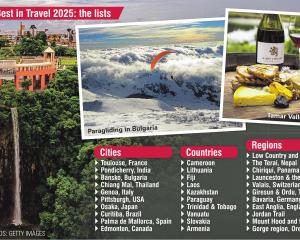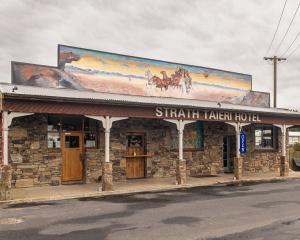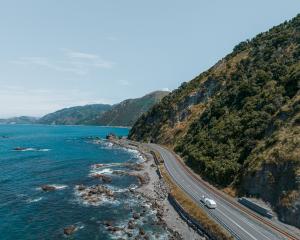Former Otago Daily Times editor Robin Charteris spits into his whisky as he rounds Cape Horn, or does he?
A funny thing happened on our way around the Horn. Cape Horn, that is.
We didn't actually go around it.
For a year and more Judi and I had looked forward to this day, this climax of our latest adventure.
We were going to sail in style around illustrious Cape Horn; follow in the wake of mighty mariners and dauntless explorers; take on the raging vortex where Atlantic, Pacific and Southern seas join in oceanic fury; go down, if not in history, perhaps in family folklore.
But a cautious Italian skipper scuppered our plans just seven hours and 100-odd nautical miles out.
Predictions were for 100mph (161kmh) winds and 10m high waves at the Horn, Captain Nicolo Bommarco announced: too rough for the 109,000-tonne luxury cruise liner Golden Princess.
We were changing course to traverse the southern tip of South America via the more sheltered Beagle Channel, a few miles north of the Horn.
What an anticlimax!
We'd paid good money for this thrill of a lifetime.
Now we were to be thwarted by a bit of a breeze, a few wild waves and some worries about upset tummies.
What price adventure!
What 21st-century wimps sail the seas today!
Still, we did tell ourselves after some reflection, the captain was in sole command, and in these fraught days of health and safety legislation - and American-style litigation - could we blame him?
He did have almost 4000 souls to care for, and very many of them were God-fearing large-tummied litigation-hungry Americans. Besides, that other Italian captain had got into big trouble in the Mediterranean recently for being a bit, ah, rash.
So, under sufferance, we did the Beagle thing; and it wasn't half bad, either.
Incidentally, Cape Horn is not shaped like a horn, as the name suggests, nor is it named for animal or beast.
It was called Kaap Hoorn in 1616 by the Dutch mariner Willem Schouten, after a vessel he had just lost.
That ship had been named for the town of Hoorn at home.
And the Horn isn't located on the South American landmass, either.
It's the southern tip of the final small island (Isla Hornos) of the Tierra del Fuego archipelago of islands at the foot of South America.
It lies well below the Roaring Forties at latitude 56degS (Stewart Island is 47degS).
What a bugger, though, not to see the Horn and not to round it.
Doing so, apparently, gives you the right to spit into the wind, if you want to risk it.
And, according to maritime lore, you can also call yourself a ''mossback''; or, even rarer, a ''horned shellback'', if your voyage rounds Cape Horn and crosses the equator, as ours was supposed to do.
I was spitting into my whisky a bit as we steamed majestically up the Beagle Channel.
We had friends and family to face on our return to Dunedin, and they'd been led to believe this was a journey of some intrepid moment.
Now it was just another cruise.
But upcoming Ushuaia and Tierra del Fuego - ''the End of the World'' - were themselves to prove pretty exciting; and the cruise as a whole (just our third: we were cruising novices really) had plenty of other highlights to make memorable indeed the 31-day trip from Buenos Aires down and around South America and up the other side to Los Angeles.
• Buenos Aires had been interesting, in the way of all large foreign cities, with distinct neighbourhoods of rich and poor.
It sits on the southern bank of the estuary of the chocolate-coloured River Plate which we crossed on our first night to awake in the Uruguayan capital of Montevideo on the northern bank.
Here, we searched for remains of the Graf Spee, the German pocket battleship scuttled in 1939 after engagement with Allied naval forces that included HMNZS Achilles.
An anchor and some rusting steel are on land near the port, we learned, and there is a memorial nearby.
The hull of the ship itself remains where it was, in just 11m of water close to the city, but salvagers, authorised and otherwise, have removed much of the rest.
Late summer quickly became late autumn as we steamed south, calling at Puerto Madryn, a bare, unprepossessing port city settled in 1865 by 153 Welsh colonists who wanted to found a New Wales in Argentinian Patagonia.
They and their descendants struggled on for years.
Until recently, visitors were served Welsh afternoon teas in some inland Patagonian towns but few reminders now remain.
We hit the Furious Fifties as we neared the Falkland Islands on a southeasterly course. Seas and skies darkened and the wind grew stronger. Our floating palace even rolled and pitched, slightly.
Fortunately, we were able to anchor offshore at Stanley and visit the British outpost by tender.
Up to 20 cruise ships call here each December to March season, but fewer than half strike weather conditions that allow such landings.
The barrenness of the place and its isolation struck us first. A series of little bleak hills rose gently from the Atlantic Ocean as we approached East Falkland, the larger of the two main islands (of 778 islands in total!).
We saw no trees, no shrubs, no sheep, no signs of civilisation even until the ship's tender rounded a headland and entered Stanley.
Then, as we clambered ashore, we were struck by the Britishness of the place.
Here were Landrovers and Mini Coopers, all with British number plates; a pair of British pubs; several tea shops; British gift shops; locals in ''wellies'' and oilskins; a variety of British accents; and even pounds, shillings and pence (Falkland Islands-issue, of course, though real quid are interchangeable).
In four hours ashore, we had sunshine, rain, sleet, wind and wild weather.
Warmth was provided by the friendly locals, most politely keen to extract our tourist dollars.
Some 3000 people live permanently on the Falklands, their industry based on sheepfarming, fishing and, to an increasing degree, tourism.
Four oceangoing yachts were moored in the harbour and several fishing trawlers close to a processing factory.
The local weekly, Penguin News, referred to 1060 British Army personnel being on the islands at present.
Five plus a dog and collection bucket were soliciting for donations along the main street by posing for photographs with tourists; trade was good, but the squaddies declined to specify the charity involved.
• Conditions did worsen a bit as we headed southwest towards the tip of South America, some 400 nautical miles away.
The sea was sucking and swirling, a stiff breeze flattening the wave tops and sending spume surfing away under a slate-grey sky; menacing enough to alarm our prudent captain, I suppose, when coupled with his weather reports.
Tierra del Fuego (Land of Fire) now opened up to us somewhat earlier than expected by the sheltered Beagle Channel route, was a huge, wonderful wilderness.
Albatrosses hovered above; land grew to starboard, first low, grey, gently rising hills, next suddenly rounded then suddenly triangular mountains, snow-capped, cloud-capped, soaring upwards, one after the other; not a sign of man to be seen.
We had gentle blue seas, the sky a mix of grey, blue and white; fittingly, the very colours of the Argentinian flag.
Eventually, we came to Ushuaia (oo-shoo-AYE-ah), where, at 54deg 48min south, almost everything is claimed to be ''the southernmost in the world'' - city, local railway, national park, university campus, gift shop, even golf course.
The nine-hole course with a bustling little river through the middle is playable only in summer, and charges visitors $US130 a round.
Not for nothing does this city of 80,000 people have the reputation of being one of the most expensive in South America.
It is also literally at the end of the road in all of America: the Panamerican Highway, which starts 30,000km away at Prudhoe Bay, in far-off Alaska, ends right here.
The vista from the moored Golden Princess in Ushuaia was spectacular.
In front of us was the research vessel National Geographic Explorer, fresh from the Antarctic; across the harbour were the city's low buildings, many of the houses wooden with gingerbread decorations Russian-style; immediately behind were the densely forested and snow-topped Martial Mountains, vertiginous peaks marching north one after another, into the Andean distance.
Three hours after departing Ushuaia, now in Chile, we navigated ''Glacier Alley''.
Between one and three kilometres wide, this portion of the Beagle Channel runs between myriad islands and fiords.
A remote wilderness area, the land was devoid of vegetation, animals and people.
Mountains, glaciers, seals and dolphins were our companions for several hours until darkness fell.
Overnight, we entered the western end of the Strait of Magellan, awakening in Punta Arenas.
A dozen passengers flew from here to the Antarctic for the day: there and back, lunch on the ice, all for $US3000.
Judi and I taxied into the town centre, went to a market and snapped the huge statue of Ferdinand Magellan, the Portuguese sailor who found the Pacific Ocean so peaceful after being blown through the strait from a stormy Atlantic in 1520 that he named it so.
Our ''best'' glacier viewing was yet to come.
Next day, in the massive southern Patagonian icefield - sufficient ice to provide fresh water to the world for 50 years and the second-biggest ice field in the world next to Greenland - we met head-on the Amalia, or Skua, Glacier.
More than 20km long, its face was 4km wide across our bow at the end of a huge fiord.
High up on Golden Princess, warm and cosy, fed and watered in our comfy balcony stateroom, we toasted the memorable view of glacier, mountains, ice and snow.
Amalia Glacier is one of 10 local glaciers this size.
The biggest, three times larger, is rather unusually named Pope Pius XI.
The cruise days that followed took us away from the southern tip of South America north up the Chilean and Peruvian coasts into increasingly warmer weather and quite different environments.
Ten days after leaving Amalia Glacier, on day 22 of our cruise, we officially earned the right to call ourselves ''shellbacks'' when Golden Princess crossed the equator.
But we wondered then, and still do today: can we, with hands on heart, truly promote ourselves to the rank of ''shelled hornbacks''?
Because we didn't really go around Cape Horn, did we.
Funny thing, that.












